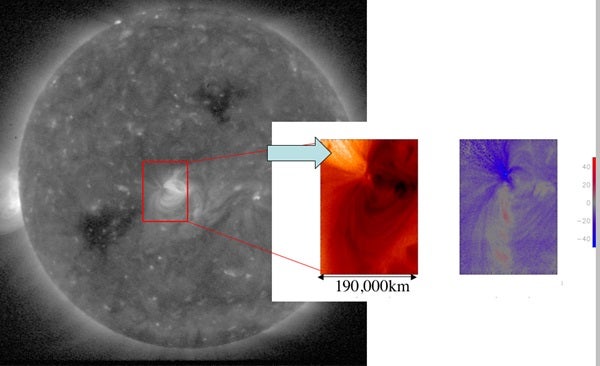February 20, 2007. The insets show the flow of gas away from the bright region marked on the left. The blue image indicates material flowing towards us that will eventually make up the solar wind and the red image shows material flowing away from us back towards the surface of the Sun.
An international team of scientists has found the source of the stream of particles that make up the solar wind. In a presentation on Wednesday April 2 at the RAS National Astronomy Meeting (NAM 2008) in Belfast, Professor Louise Harra of the UCL-Mullard Space Science Laboratory will explain how astronomers have used a UK-led instrument on the orbiting Hinode space observatory to finally track down the starting point for the wind.
The solar wind consists of electrically charged particles that flow out from the Sun in all directions. Even at their slowest, the particles race along at 200 kilometers per second, taking less than 10 days to travel from the Sun to the Earth. When stronger gusts of the wind run into the magnetic field of the Earth there can be dramatic consequences, from creating beautiful displays of the northern and southern lights to interfering with electronic systems on satellites and sometimes even overloading electrical power grids on the ground.
From its launch in the autumn of 2006, scientists have used the Hinode mission to study the Sun in unprecedented detail. One of the instruments on the probe, the UK-built Extreme Ultraviolet Imaging Spectrometer (EIS) measures the speed at which material flows out from the Sun.
The Sun is a cauldron of hot gas shaped by magnetic fields, which create bright regions of activity on the solar surface. Using EIS, the scientists found that at the edges of these bright regions hot gas spurts out at high speeds. Magnetic fields connect the regions together, even when they are widely separated. For example, in the Hinode images that Harra will present on Wednesday, magnetic fields linked two regions almost 500,000 kilometers apart — a distance equivalent to 40 Earths placed side by side in space. When magnetic fields from two regions collide they allow hot gas to escape from the Sun — this material flows out as the solar wind.
Harra says, “It is fantastic to finally be able to pinpoint the source of the solar wind — it has been debated for many years and now we have the final piece of the jigsaw. In the future we want to be able to work out how the wind is transported through the solar system.”










